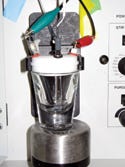Originally Published MDDI May 2006 R&D Digest: The monthly review of new technologies and medical device innovations. Maria Fontanazza
May 1, 2006
R&D Digest: The monthly review of new technologies and medical device innovations.
|
The portable sensor from researchers at UC Santa Barbara could be adapted to a wide range of in vitro applications. |
A cocaine-detecting device could open the door to identifying a range of both legal and illegal drugs in minutes. The portable, handheld sensor built by researchers at the University of California, Santa Barbara, is designed to spot cocaine in saliva or blood, but its concept could be altered for a range of medical applications.
“This was really just proof of principle—it's just the tip of the iceberg,” says Kevin Plaxco, associate professor in the department of chemistry
and biochemistry at the university. “There are so many targets and DNA molecules, and so many ways we can further optimize this system. I'm pretty confident that there will be a lot of targets that we can detect at clinically relevant levels.”
Plaxco envisions using the sensor to rapidly identify both illicit and licit drugs, especially those that need to be carefully monitored. He used the example of cyclosporine, a medication that is used to prevent rejection following a transplant. “The therapeutic-to-toxic dose ratio is very tight, so clinicians have to very carefully assay the blood concentration of the drug in every patient.” Current assays can take as long as six hours; the cocaine sensor can achieve a result in less than 90 seconds.
To detect the cocaine in the proof-of-principle experiment, the team used a class of DNA molecules called aptomers, which are designed to bind to various targets. The DNA visibly changes as the electrons travel through it. In the absence of the target, the DNA is floppy and unfolded. In the target's presence, it becomes rigid, compact, and folded. “Here we took [an aptomer] that binds cocaine, but there are aptomers available that bind lots of other targets of clinical interest,” says Plaxco. “It's relatively easy to reengineer these aptomers so that they undergo binding-induced folding.”
The device is constructed of both commercially available parts and components developed by the researchers. They're working on making an independent, palm-top instrument. “The first electronic package is just three chips on a little breadboard. It's very simple,” says Plaxco. The three small electrodes are millimeters in dimensions, made of 100-µm gold spots. The electrodes are in a test tube and connected by wires to a potentiostat, which is a little palm-sized box that's wired to a computer.
So far, the researchers have been using off-the-shelf electronics in the device. They're now working closely with cosmologists to improve and develop their own electronics. “[The cosmologists] study the cosmic microwave background and are good at building low-noise amplifiers and subtracting out background,” says Plaxco. Improving the electronics will also make the test more sensitive, which is necessary for use in emergency rooms. “Ultimately our sensitivity is limited by how well we can subtract the background signals that we get in the absence of any target. We're working on improving ways of doing that subtraction.”
The team is currently looking at the comprehensive potential of the test. “We want to explore more targets to get a better feeling for how many we can detect at clinically relevant levels.” They're also collaborating with DNA labs to design better aptomers.
The research group included two high school students and Nobel Prize recipient Alan Heeger. More details about their research can be found in the February issue of the Journal of the American Chemical Society.
Copyright ©2006 Medical Device & Diagnostic Industry
About the Author(s)
You May Also Like



